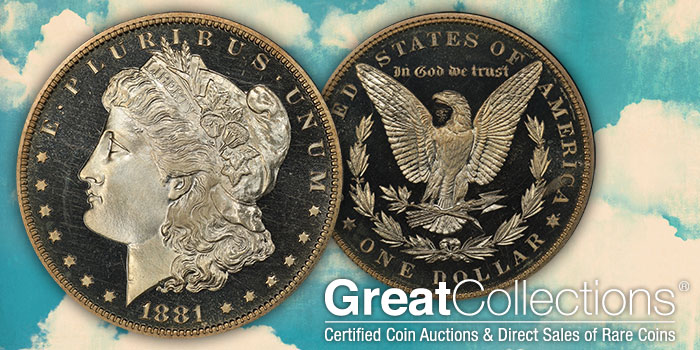
By CoinWeek ….
In three days–on Sunday, July 28–bidding ends on GreatCollections.com for this 1881 Proof Morgan dollar, graded PR67CAM by PCGS and sealed in a Secure Shield holder.
Only the Philadelphia Mint produced Morgan dollar Proofs in 1881, and only 984 pieces were struck. This alone makes the 1881 Proof scarce, but when condition is taken into account (including both strike and the presence of Cameo) it becomes truly rare–most especially in Mint State. PCGS reports a mere 70 pieces graded at PR-60 CAM and above, with just nine graded PR-67 CAM. A handful of coins grade higher; three in 67+, one in 68, and one in 69.
Auction records are relatively extensive for PCGS-certified Proof 67 Cameos. In April 2016, an example sold for $17,625 USD. Two years earlier, in March, a specimen went for $14,100 – almost $4,000 less than the most recent record. But then four months before that sale, in November 2013, a PR-67 CAM example garnered $16,450. And the year before that, a piece sold for $12,338 in August.
However, the biggest variance in prices realized happened between that auction and an August 2011 sale, when an 1881 Morgan Proof graded PCGS PR-67 CAM went for $46,000 – the current record price for the entire issue.
To check GreatCollections for their sales involving Morgan dollars, search through the GreatCollections Auction Archives, with records for over 600,000 certified coins the company has sold over the past seven years.
At the time of publication, the price for this Proof 67 Cameo 1881 Morgan silver dollar is $12,000 after 22 bids.
Background of the 1881 Morgan Dollar
The Morgan dollar gets its name from United States Mint engraver George T. Morgan, who designed the dollar coin in competition with then-Chief Engraver William Barber. Contrary to received numismatic wisdom, the two men had a cordial professional relationship.
Morgan was born in England and began working for the Mint soon after his arrival in the United States in 1876. Morgan was brought on as an assistant engraver in October 1876 and then worked under William Barber. In addition to the Liberty Head dollar, Morgan has several coin design credits to his name, including the Columbian half dollar of 1892 and 1893, and an array of pattern coins designed during the late 19th century, most notable of these being the never-released $100 Gold Union coin.
The obverse of the 1881 Morgan dollar exhibits the left-facing Liberty Head motif seen on all issues of this classic dollar series. The central Liberty bust wears a Phrygian cap encircled with a ribbon adorned with the inscription LIBERTY. Miss Liberty also wears a crown of wheat and cotton, which were two of the nation’s most lucrative natural agricultural assets in the 19th century.
The phrase E PLURIBUS UNUM is inscribed along the upper half of the obverse rim, and the date 1881 is centered at the bottom of the obverse adjacent to the rim. Seven stars appear between the left side of the date and the inscription E PLURIBUS UNUM, while six stars fill the gap between the date and motto on the lower right side of the coin. In total, the 13 stars represent the 13 colonies that combined to form the original Union of the United States. At the base of Liberty’s neck is the “M” monogram representing Morgan’s initial.
Morgan designed the Liberty head bust after the likeness of Anna Willess Williams, a Philadelphia schoolteacher who modeled for the coin. Williams received significant public recognition after her face appeared on the Morgan dollar but she rejected it, refusing offers for acting roles and apparently marriage following her engagement to an unknown suitor.
The reverse of the 1881 Morgan dollar is dominated by a heraldic eagle, its wings spread across the upper half of the coin. Between the upper tips of the eagle’s wings appears the motto IN GOD WE TRUST. The eagle clutches an olive branch in its right claw representing peace and in its left claw are three arrows symbolizing the nation’s ability to defend itself. The central eagle design is partly encircled by a laurel wreath.
Along the rim of the upper two-thirds of the reverse is the legend UNITED STATES OF AMERICA, with the tip of the eagle’s left wings, which virtually touch the coin’s rim, penetrating the space between UNITED and STATES; the right wing visually divides the words OF and AMERICA. The words ONE DOLLAR, seen at the bottom center of the reverse, are flanked by a single, six-sided star on either side of the denomination inscription.
(The edge, of course, is reeded.)
As noted above, only 984 Proof Morgan dollars were struck at the Philadelphia Mint that year. The Treasury Department sales of the GSA Hoard in the 1970s and early ’80s did not disrupt then-current census numbers for the 1881 as much as it did for many other rare Morgan dollar issues.




